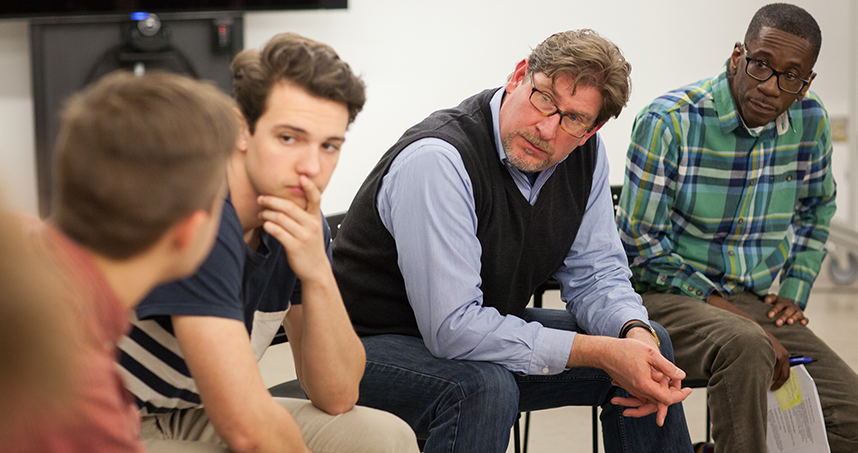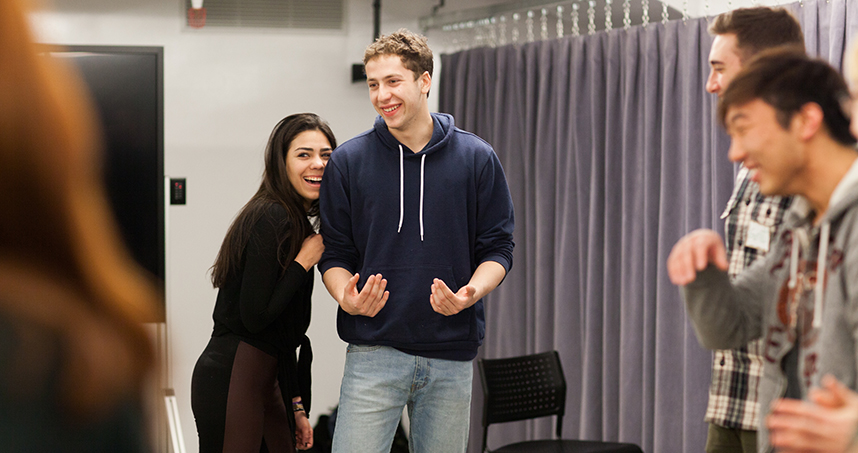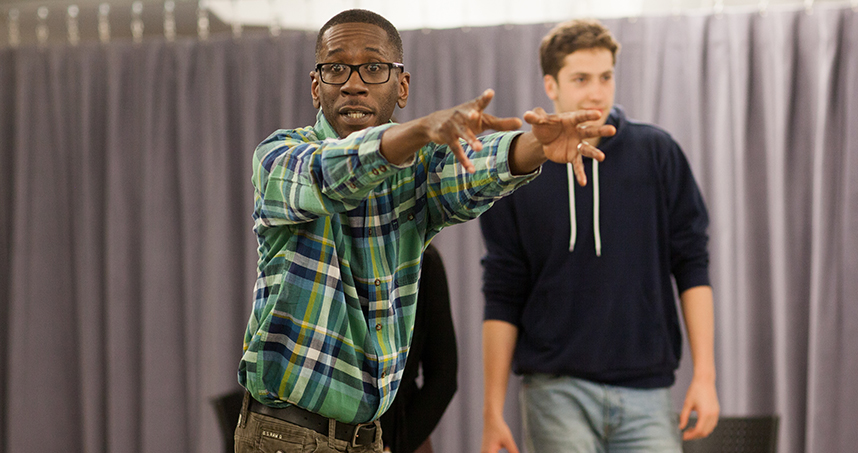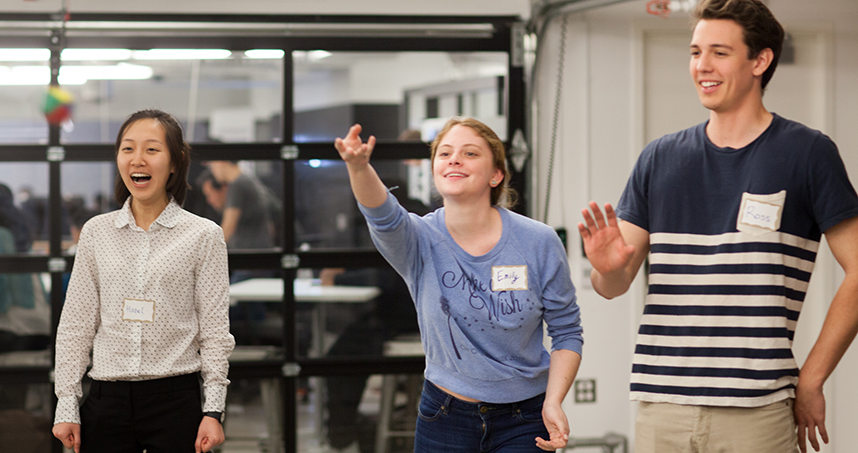Engineers Learn the Art of Allowing
Improv course imparts whole-brain skills
It’s a lively Wednesday evening in The Garage, and Northwestern Engineering’s Joe Holtgreive is tossing and catching an invisible ball.
“TVs are like…” says a male student in glasses with orange headphones as he passes the “ball” to Holtgreive.
“TVs are like bottomless pits,” Holtgreive says after catching the “ball.” “Because once you fall in, you can’t stop yourself.”
A red-haired female student catches the ball and adds “Dancing is like…” before passing it to a tall student in a red plaid shirt.
“Dancing is like a box full of puppies,” he says. “It’s really cute but not for everyone.”
The class erupts with laughter.
This is PRDV 397: Engineering Improv: The Art of Allowing. The course introduces Northwestern Engineering undergraduates to improvisational techniques, including developing sensory awareness, attention and focus, collaboration, trust and support, storytelling skills, and commitment to character.
Co-taught by Holtgreive and adjunct lecturer Byron Stewart, the course is offered through the Office of Personal Development, which helps undergraduate students develop accurate self-awareness by creating an environment that encourages them to explore available opportunities and engage in new experiences. The office also offers PRDV 395: Whole Body Engineering, which challenges engineers to collaborate through partner dancing, and PRDV 325: Emotional Intelligence 101. All courses are designed to get students out of their comfort zones to inspire creativity and shake loose rigid patterns of thinking and doing.
 “Improv helps students learn how to trust their instincts when they need to make quick decisions,” says assistant dean Holtgreive, director of the Office of Personal Development. “Then they can apply these same skills to meet life challenges.”
“Improv helps students learn how to trust their instincts when they need to make quick decisions,” says assistant dean Holtgreive, director of the Office of Personal Development. “Then they can apply these same skills to meet life challenges.”
Studying engineering can sometimes be an isolating and cerebral experience, in which students are tightly focused on their own work and grades. Improv challenges these students to get out of their heads and into their bodies to build collaborative scenes with others. The team-building aspect of improv not only helps engineering students work in teams in their classes but prepares them for fruitful collaborations later in their professional careers.
“If your attention is focused on yourself, your ability to improv is blocked,” Holtgreive says. “Learning to improv requires engineering students to direct their attention outward toward their partners in a scene as they work to make everyone else successful. They receive and achieve success by giving to others and making everyone else successful.”
Improv also helps students access and exercise their right brains by embracing creativity, intuition, and metaphorical thought. By using the right brain, engineers can look at problems through a new lens, which is crucial for brainstorming creative solutions to problems and implementing the design process. Combining the technical left brain with the creative right brain allows engineering students to innovate, lead, and bring new ideas to life.
“The very first thing I fell in love with at Northwestern was this idea of whole-brain engineering,” says Caroline Kaden, a sophomore in chemical engineering. “To truly engineer is to create, to problem solve, and to analyze from different directions. None of these are possible without both sides of your brain, and improv is one of many ways for engineers to open up the right side of the brain.”
Each class begins with an improv warm-up, such as passing the “metaphor ball” back and forth, that embolden the students to avoid overthinking. Then, for the remainder of the first hour, the students sit in a circle to discuss assigned readings and past homework with Holtgreive and Stewart. Students spend the second hour doing improv exercises designed to introduce and build necessary improv techniques and skills before ending the final hour with directed scene work. This week, the class discusses the art of allowing as opposed to controlling or dismissing.
 “Allowing can be allowing someone to affect us or change us,” says Stewart, who has an extensive background as an applied theatre consultant. “It could be allowing others to change our way of thinking.”
“Allowing can be allowing someone to affect us or change us,” says Stewart, who has an extensive background as an applied theatre consultant. “It could be allowing others to change our way of thinking.”
“The excitement of allowing is that you don’t know what’s coming,” Holtgreive adds. “You give up control, but you gain mystery.”
This art of allowing can be freeing for engineering students who are accustomed to planning every detail. By applying improv principles, students can become more open to taking risks and exploring new collaborations and more confident when delivering presentations or speaking publicly.
“‘Say yes’ is incredibly important when it comes to brainstorming,” says Aditya Jain, a senior who is double majoring in industrial engineering and applied mathematics. “‘Just show up,’ ‘start anywhere,’ and ‘act now’ are very relevant to the iterative design process where a person or team need to be ready to continuously push out ideas and try different things.”
In the end, Holtgreive and Stewart hope the class exposes the students to different ways of thinking and inspires them to live “in the moment.” But beyond the students’ needs, the pair wants the audience to get something out of it too.
“The opportunity to help people escape is a gift,” Stewart says. “Giving back is what we live for.”
Based on student demand, the Office of Personal Development is offering a second five-week Engineering Improv course in fall 2016. Engineering Improv I will take place in the first five weeks of the quarter, and Engineering Improv II will take place in the last five weeks. The first course is a prerequisite for the second.
“Engineering Improv has been one of the most rewarding classes I have taken at Northwestern,” says Samuel Remler, a junior in industrial engineering. “Not only because it was a lot of fun but because of how much I learned about myself and what I can change as a student.”



